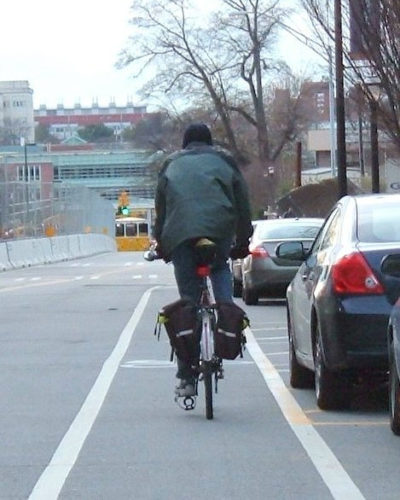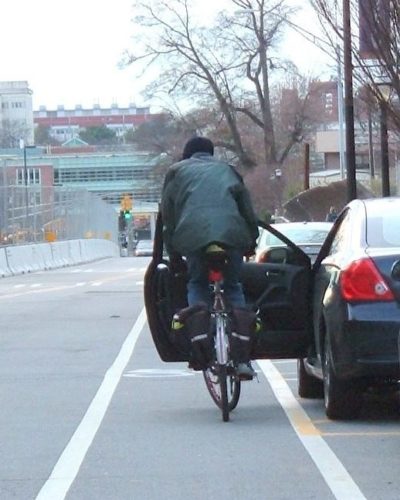By Ken Christensen and Russ Hymas — Is “dooring” something you worry about often as a cyclist? For those unfamiliar with the term, think about the last time you rode along a crowded downtown street, or passed a long line of parked cars near a trailhead on Wasatch Boulevard. Did your blood pressure rise, fearing that a door might fling open just as you pass by? “Dooring” is the term used when a cyclist crashes into a suddenly opened car door along the shoulder of the road. No matter how safely you ride your bike, it is difficult, if not impossible, to predict the actions of other people, especially drivers and passengers in parked cars. Dooring collisions are most common in urban communities but can happen anywhere and anytime, especially since Utah does not prohibit parking a car in a bicycle lane.

An observation study in New York City counted 77 dooring infractions in only 3 days. Despite this dangerous behavior by drivers, insurance companies and their attorneys routinely try and argue that the cyclist bears fault for dooring collisions or that the cyclist must prove that the driver or passenger failed to act in a careful manner before opening the door. This is contrary to Utah law! Utah (along with 39 other states) specifically assigns responsibility on the person opening the car door, rather than the cyclist passing their vehicle.
Utah Code Section 41-6a-1704 states that “a person may not open the door of a motor vehicle on a side available to moving traffic unless it can be done safely and without interfering with the movement of other traffic” (this would include cyclists). The statute also makes it illegal to leave a door open for extended periods of time. This law provides a clear duty for people to look for traffic – whether bikes, cars, or pedestrians – before opening their doors. Without this law, the burden would be placed on the cyclist to show that they could not avoid the driver’s opened door in order to recover for injuries and bike damage.
Other states should have similar laws on their books. Non-Utah residents should check their own state’s traffic codes for specifics in that state.

A 2020 Florida survey found that 59% of drivers never check behind them before opening their doors. Most car doors are 5 feet in width and Utah has an abundance of trucks and SUV with even wider doors. Typical bike lanes next to parked cars are narrower than 5 feet and insufficient for cyclist safety. So, what should a cyclist do when riding next to parked cars? Utah Code Section 41-6a-1105 says that if a cyclist is traveling slower than the flow of traffic, a cyclist must ride as close to the right-hand edge of the roadway as practicable. But the law also has a specific exception to this rule when avoiding unsafe conditions along the right side of the road such as parked cars or debris. When you’re riding along parked cars, it is legal to move further into the roadway, even ride in the travel lane, as long as you do so carefully.
“Taking the lane” can be a controversial topic among cyclists and motorists. Many drivers begrudgingly acknowledge a cyclist’s right to take the lane when the cyclist is moving with the speed of traffic. Those same drivers, however, cannot appreciate the danger of car doors opening and can become hostile and aggressive when a cyclist takes the lane in order to avoid hazards on the right side of the road. When necessary, give proper notice, take the lane, and then return to the right-hand edge of the roadway as quickly as possible. As cyclists, we can legally take the lane, but that doesn’t mean we can keep it.
If you’re involved in a dooring collision, turn on your cell phone camera and video as much as you can immediately afterwards. Many drivers accept fault and apologize immediately afterwards. Don’t let the driver or their insurance company blame you for the accident. Utah law is clear – drivers must check their blind spots and make sure they can open the door safely.

